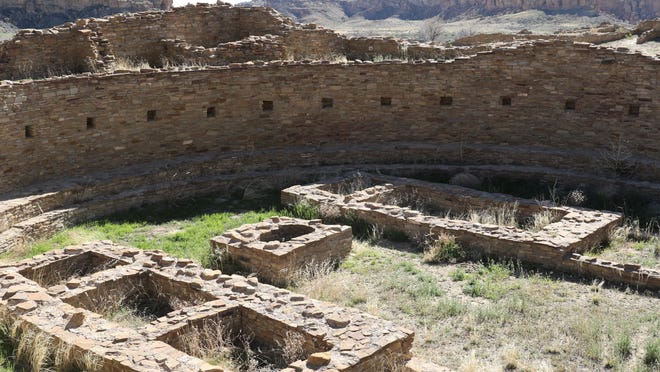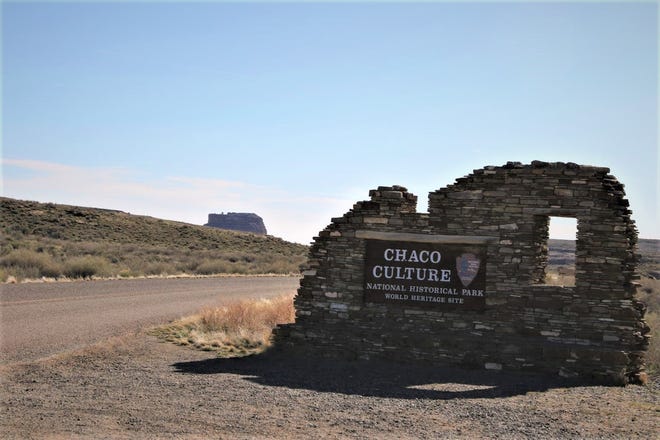BLM preferred plan could open areas within 10-mile Chaco buffer to oil, gas development
Resource management plan amendment would increase areas with no surface occupancy stipulations

- Activists criticized the draft amendment as failing to protect the Greater Chaco landscape.
- The draft amendment documents say the proposed action would lead to at most a 1% reduction in BLM-permitted well development.
FARMINGTON — A plan for future development would open up lands within the current 10-mile Chaco Culture National Historical Park buffer zone to oil and gas leasing.
The Bureau of Land Management and Bureau of Indian Affairs released the draft resource management plan amendment for the Farmington Field Office on Feb. 28 and it will be available for comment through May 28. The draft amendment has been posted online for review.
This amendment to the 2003 plan has been in the works for six years.
Activists say plan fails to protect communities, cultural sites
During the process of drafting the amendment, the BLM has foregone new oil and gas leasing within a 10-mile radius of Chaco Culture National Historical Park. The preferred action highlighted in the amendment could open up much of that land to oil and gas leasing by reducing the size of that buffer zone. This sparked widespread criticism from activists who have been lobbying for a permanent buffer zone around the park.

"“The BLM’s draft Farmington plan fails to protect Navajo communities and the air we all breathe," said Carol Davis, the director and coordinator for Diné Citizens Against Ruining Our Environment in a statement. "It envisions opening the entire Chaco Protection Zone, and Greater region, to oil and gas drilling and leasing, including lands that directly border the park. It is a step in the wrong direction and without additional oversight and limits on methane emissions, oil and gas pollution will continue to disproportionately affect children, indigenous communities, and those living in poor, rural areas. In the absence of federal leadership, we appreciate Governor (Michelle) Lujan Grisham’s commitment to cut methane emissions and tackle climate change.”

Meanwhile, archaeologist Paul Reed criticized the proposed alternative as failing to protect the fragile, undeveloped land rich in historical and cultural resources that surrounds Chaco Culture National Historical Park. He said in a statement that encroaching oil and gas development could cause irrevocable damage to those resources.
The amendment documents describe Chaco Culture National Historical Park as "one of the most exceptional concentrations of archaeological sites in the American Southwest from the tenth to twelfth centuries AD" and as "one of the most important Pre-Columbian cultural and historical areas in the United States."

In addition to the archaeological sites in the park boundaries, the region includes outliers and sites associated with the Navajo, including hogans and defensive sites. There are thousands of archaeological sites in the San Juan Basin and new ones are identified every year.
Preferred alternative includes various sizes of possible buffer zones
The preferred alternative includes six sub-alternatives with varying sizes of buffer zones ranging from two-miles to 10-miles. In addition to the buffer zone around the park, it would also include varying sizes of buffer zones around the Chacoan outliers Pueblo Pintado and Kin Bineola.
There are currently 737,700 acres open for leasing for oil and gas development. The preferred alternative would reduce this to between 558,100 and 663,900 depending on the sub-alternative.

This would have minimal impact on oil and gas development, according to the document. According to the analysis, there would be at most a 1% reduction in BLM-permitted well development.
Additional stipulations added in preferred alternative
Rather than setting aside large swaths of land in buffer zones, the preferred alternative relies on stipulations such as a no surface occupancy stipulation around Chacoan outliers and roads.
The preferred alternative increases areas with no surface occupancy stipulations. Jackson Lake Wildlife Area north of Farmington would be added to the list of areas where surface occupancy is not allowed.
Oil and gas developers would also face no surface occupancy stipulations within 0.7 miles of historical sites and within 1,000 feet of domestic wells.
The alternative also adds no surface occupancy stipulations to areas where there is yellow-billed cuckoo or southwestern willow flycatcher habitat.
NMOGA says plan should balance resource protection, energy interests
New Mexico Oil and Gas Association spokesman Robert McEntyre said NMOGA is reviewing the document and will submit formal comments in the near future.
"New Mexico has safely produced oil and natural gas in the San Juan Basin for decades while at the same time protecting the cultural and historic treasures throughout the region," he said in an email. "We can continue to do both, while also growing jobs, expanding the local economy, and providing funding for our public schools. Local residents and allottees have made their voices clear: limiting development in the region will only disrupt the largest and most successful part of New Mexico’s economy and will rob their communities of jobs and economic growth opportunities."
McEntyre said NMOGA hopes the plan will recognize the rights of existing producers and balance protection and preservation of cultural resources with energy production to support the economy, public schools and local jobs.
Other alternatives considered
The amendment considered various alternatives, including buffer zones around Chaco Culture National Historical Park of up to 15 miles. The alternatives also considered buffer zones around Chacoan roads and outliers.
The alternative that would have the most impact on oil and gas development could result in a 40% reduction in new oil and gas development and would have included a 15-mile radius buffer zone. It was evaluated to address concerns about impacts to Chaco Culture National Historical Park, its entrance road, the Great Northern Road and other Chacoan sites. The alternative also proposed two-mile buffer zones around Navajo Lake and the Cutter Reservoir. In addition, it would have closed Jackson Lake Wildlife Area to leasing.

Another alternative aimed at reducing impacts to ecosystems could result in a 25% decrease in new development, despite only including a two-mile buffer zone around Chaco Culture National Historical Park. It would have also included two-mile buffer zones around Chacoan outliers and roads as well as around Navajo Lake and Cutter reservoir. The alternative would also have closed Jackson Lake to leasing. It also included an increased number of areas with no surface occupancy stipulations.
How to comment
The document will be available for comment through May 28.
Comments can be submitted on the website go.usa.gov/xdrjD or by email to blm_nm_ffo_rmp@blm.gov. They can also be faxed to Jillian Aragon, the project manager, at 505-564-7608 or mailed to the Bureau of Land Management Farmington Field Office Attn: Project Manager, 6251 College Blvd. Suite A, Farmington, NM 87402 or the Bureau of Indian Affairs Navajo Regional Office Attn: Robert Begay, P.O. Box 2060 Gallup, NM 87301.

Find a copy
Copies of the draft resource management plan can be found at the following locations:
- The BLM Farmington Field Office
- The BIA Southwest Regional Office in Albuquerque
- The BIA Navajo Regional Office in Gallup
- The BIA Eastern Navajo Agency in Crownpoint
- Navajo Nation Library in Window Rock, Arizona
- Farmington Public Library
- The BLM New Mexico State Office in Santa Fe
- Pueblo Pintado Chapter House
- Whitehorse Lake Chapter House
- Torreon Chapter House
- Ojo Encino Chapter House
- Counselor Chapter House
- Nageezi Chapter House
- Lake Valley Chapter House
- Huerfano Chapter House
- Upper Fruitland Chapter House
- San Juan Chapter House
- Hogback Chapter House
- Burnham Chapter House
- White Rock Chapter House
- Becenti Chapter House
Hannah Grover covers government for The Daily Times. She can be reached at 505-564-4652 or via email at hgrover@daily-times.com.
Support local journalism with a digital subscription: http://bit.ly/2I6TU0e
